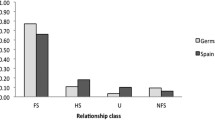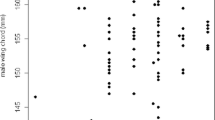Abstract
Even though a considerable number of genetic markers are available for paternity analysis in birds, significant difficulties can arise in the assessment and interpretation of data. Paternity analyses using genetic markers are based on comparing similarities and dissimilarities (mismatches) between candidate fathers and their putative offspring. Complications arise when only a few mismatches are being detected, because any non-shared allele might well be caused by a mutation rather than being indicative of a true exclusion. To deal with such problems, it is essential to apply marker panels with sufficient discriminative power. Studying urban populations of Parus major, we report new combinations of microsatellite markers with extremely high sensitivity. We show that even marker panels with numerically satisfying discrimination power and exclusion probability (>0.99999999 and >0.999, respectively) do not always protect from insecurities. We also show that further maximisation of panel sensitivity by adding more markers can be helpful to resolve the majority of such ambiguous cases.
Zusammenfassung
Maximierung der Diskriminationsstärke ist wichtig für Untersuchungen von Mikrosatelliten-basierten Vaterschaftsanalysen bei Singvögeln
Auch wenn eine Vielzahl von genetischen Markern für Vaterschaftsanalysen bei Singvögeln zur Verfügung steht, so können sich doch erhebliche Schwierigkeiten bei der Beurteilung und Interpretation der Daten ergeben. Vaterschaftsanalysen mittels genetischer Marker basieren auf dem Vergleich von Ähnlichkeiten bzw. Unähnlichkeiten (sog. mismatches) zwischen vermuteten Vätern und ihren vermeintlichen Nachkommen. Komplikationen treten auf, wenn nur wenige Unähnlichkeiten bestehen, weil jedes nicht gemeinsame Allel ebenso durch eine Mutation bestimmt sein kann und nicht zwingend für einen echten Ausschluss sprechen muss. Um mit diesem Problem umzugehen, ist es unverzichtbar, Markerkombinationen mit genügend Diskriminationsstärke anzuwenden. Für eine Stadtpopulation von Kohlmeisen Parus major berichten wir über neue Kombinationen von Mikrosatellitenmarkern mit sehr hoher Sensitivität. Wir können zeigen, dass auch Markerkombinationen mit zahlenmäßig zufrieden stellender Diskriminationsstärke und Ausschlusswahrscheinlichkeit (>0.99999999 bzw. >0.999) nicht immer vor Unsicherheiten bewahren. Wir zeigen auch, dass eine weitere Maximierung der Sensitivität durch Hinzunahme von mehr Markern helfen kann, die Mehrzahl solch zweifelhafter Fälle aufzuklären.
Similar content being viewed by others
References
Botstein D, White RL, Skolnick M, Davis RW (1980) Construction of a genetic linkage map in man using restriction fragment length polymorphisms. Am J Hum Genet 32:314–331
Dawson DA, Hanotte O, Greig C, Stewart IR, Burke T (2000) Polymorphic microsatellites in the blue tit Parus caeruleus and their cross-species utility in 20 songbird families. Mol Ecol 9:1941–1944
Desmarais D, Zhong Y, Chakraborty R, Perreault C, Busque L (1998) Development of a highly polymorphic STR marker for identity testing purposes at the human androgen receptor gene (HUMARA). J Forensic Sci 43:1046–1049
Foerster K, Delhay K, Johnson A, Lifjeld JT, Kempenaers B (2003) Females increase offspring heterozygosity and fitness through extra-pair matings. Nature 425:714–717
Griffith SC, Owens IPF, Thuman KA (2002) Extra-pair paternity in birds: a review of interspecific variation and adaptive function. Mol Ecol 11:2195–2212
Griffith SC, Dawson DA, Jensen H, Ockendon N, Greig C, Neumann K, Burke H (2007) Fourteen polymorphic microsatellite loci characterized in the house sparrow Passer domesticus (Passeridae, Aves). Mol Ecol Notes 7:333–336
Gunn PR, Trueman K, Stapleton P, Klarkowski DB (1997) DNA analysis in disputed parentage: the occurrence of two apparently false mismatches of paternity, both at short tandem repeat loci, in one child. Electrophoresis 18:1650–1652
Hughes JM, Mather PB, Toon A, Ma J, Rowley I, Russell E (2003) High levels of extra-group paternity in a population of Australian magpies Gymnorhina tibicen: evidence from microsatellite analysis. Mol Ecol 12:3441–3450. doi:https://doi.org/10.1046/j.1365-294X.2003.01997.x
Johnson LS, Hicks BG, Masters BS (2002) Increased cuckoldry as a cost of breeding late for male house wrens (Troglodytes aedon). Behav Ecol 13:670–675
Jones AG, Small CM, Paczolt KA, Ratterman NL (2010) A practical guide to methods of parentage analysis. Mol Ecol Res 10:6–30
Kalinowski ST, Taper ML, Marshall TC (2007) Revising how the computer program CERVUS accommodates genotyping error increases success in paternity assignment. Mol Ecol 16:1099–1106
Karaiskou N, Buggiotti L, Leder E, Primmer CR (2008) High degree of transferability of 86 newly developed zebra finch EST-linked microsatellite markers in 8 bird species. J Heredity 99:688–693
Li SH, Huang YJ, Brown JL (1997) Isolation of tetranucleotide microsatellites from the Mexican jay Aphelocoma ultramarina. Mol Ecol 6:499–501
Mansuet-Lupo A, Henke J, Henke L, Blank C, Ernsting A, Kozlowski P, Rouger P, van Huffel V (2009) A paternity case with three genetic incompatibilities between father and child due to maternal uniparental disomy 21 and a mutation at the Y chromosome. Forensic Sci Int Genet 3:141–143
Nutini AL, Mariottini A, Giunti L, Torricelli F, Ricci U (2003) Double incompatibility at human alpha fibrinogen and penta E loci in paternity testing. Croat Med J 44:342–346
Richtlinien für die Erstattung von Abstammungsgutachten der Bundesärztekammer. Dtsch Arztebl 2002; 99(10):A665–667
Saladin V, Bonfils D, Binz T, Richner H (2003) Isolation and characterization of 16 microsatellite loci in the great tit Parus major. Mol Ecol Notes 3:520–522
Sefc KM, Payne RB, Sorensen MD (2001) Characterization of microsatellite loci in village indigobirds Vidua chalybeate and cross-species amplification in estrildid and ploceid finches. Mol Ecol Notes 1:252–254
Suarez NM, Gonzalez A, Betancor E, Pestano JJ (2009a) Microsatellite loci isolation in the endangered Gran Canarian blue chaffinch (Fringilla teydea polatzeki) and their utility in closely related taxa. Conserv Genet 10:581–583
Suarez NM, Betancor E, Pestano JJ (2009b) Microsatellite loci isolation in the Canarian common chaffinch (Fringilla coelebs) and their utility in other Canarian finches. Mol Ecol Resour 9:1164–1166
Tereba A (1999) Tools for analysis of population statistics, Profiles in DNA 3. Promega Corporation, available at: http://www.promega.com/geneticidtools/powerstats/
Author information
Authors and Affiliations
Corresponding author
Additional information
Communicated by M. Wink.
Electronic supplementary material
Below is the link to the electronic supplementary material.
Rights and permissions
About this article
Cite this article
Poetsch, M., Bähnisch, E., Ludescher, F. et al. Maximising the power of discrimination is important in microsatellite-based paternity analysis in songbirds. J Ornithol 153, 873–880 (2012). https://doi.org/10.1007/s10336-012-0813-7
Received:
Revised:
Accepted:
Published:
Issue Date:
DOI: https://doi.org/10.1007/s10336-012-0813-7




